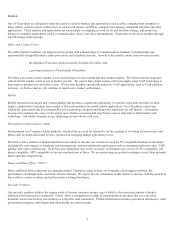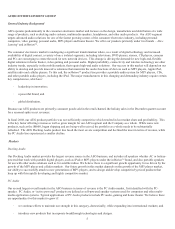Plantronics 2008 Annual Report Download - page 19
Download and view the complete annual report
Please find page 19 of the 2008 Plantronics annual report below. You can navigate through the pages in the report by either clicking on the pages listed below, or by using the keyword search tool below to find specific information within the annual report.13
mix of our B2B to B2C customers as well as our product mix. In the AEG segment, our prices and gross margins are
generally lower for our PC Audio products than our Docking Audio products. Therefore, our profitability depends, in
part, on our mix of PC Audio to Docking Audio products. The size and timing of our product mix and opportunities in
these markets are difficult to predict;
xwe are working [to refresh virtually the entire AEG product line; however, market adoption of new products is difficult
to predict;
xa significant portion of our annual retail sales for AEG generally occur in the third fiscal quarter, thereby increasing the
difficulty of predicting revenues and profitability from quarter to quarter and in managing inventory levels;
xfluctuations in currency exchange rates impact our revenues and profitability because we report our financial statements
in U.S. dollars, whereas a significant portion of our sales to customers are transacted in other currencies, particularly the
Euro and Great British Pound (“GBP”). Furthermore, fluctuations in foreign currencies impact our global pricing
strategy resulting in our lowering or raising selling prices in a currency in order to avoid disparity with U.S. dollar prices
and to respond to currency-driven competitive pricing actions. We have experienced a significant favorable impact on
our gross profit in fiscal 2008 as a result of the strength of the Euro and GBP. Currency exchange rates are difficult to
predict, and we may not be able to either predict changes in exchange rates in the future and our gross profit and
profitability could be negatively impacted in the future by currency exchange rates;
xbecause we have significant manufacturing operations in Mexico and China, fluctuations in currency exchange rates in
those two countries can impact our gross profit and profitability.
Fluctuations in our operating results may cause volatility in the trading price of our common stock.
Economic conditions have been declining and there is a risk of a recession.
Our products and markets are subject to general economic conditions, and if there is a slowing of national or international economic
growth or an increase in inflation, our forecasted demand may not materialize to the levels we require to achieve our anticipated
financial results, which could in turn have a material adverse effect on the market price of our stock. In addition, we may receive
returns from our retailers of products in excess of our historical experience rate. Should product returns vary significantly from our
estimate, estimated revenues may be negatively impacted since returns net against revenue. Failure to meet our anticipated demand
could also result in excess levels of inventory, which could result in additional reserves for excess and obsolete inventory, which
would negatively impact our financial results.
The failure of our suppliers to provide quality components or services in a timely manner could adversely affect our results.
Our growth and ability to meet customer demands depend in part on our ability to obtain timely deliveries of raw materials,
components, sub-assemblies and products from our suppliers. We buy raw materials, components and sub-assemblies from a variety
of suppliers and assemble them into finished products. We also have certain of our products manufactured for us by third party
suppliers. The cost, quality, and availability of such goods are essential to the successful production and sale of our products.
Obtaining raw materials, components, sub-assemblies and finished products entails various risks, including the following:
xprices of certain raw materials, components and sub-assemblies may rise or fall depending upon global market
conditions. In general, we are experiencing a net increase in the costs of these components. If we are unable to pass
these increases on to our customers or to achieve operating efficiencies that offset these increases, our business, financial
condition and results of operations may be materially and adversely affected;
xrapid increases in production levels to meet unanticipated demand for our products could result in higher costs for
components and sub-assemblies, increased expenditures for freight to expedite delivery of required materials, and higher
overtime costs and other expenses. These higher expenditures could lower our profit margins. Further, if production is
increased rapidly, there may be decreased manufacturing yields, which may also lower our margins;
xwe obtain certain raw materials, sub-assemblies, components and products from single suppliers and alternate sources
for these items are not readily available. Any failure of our suppliers to remain in business or to be able to purchase the
raw materials, subcomponents and parts required by them to produce and provide to us the parts we need could
materially adversely affect our business, financial condition and results of operations;
























